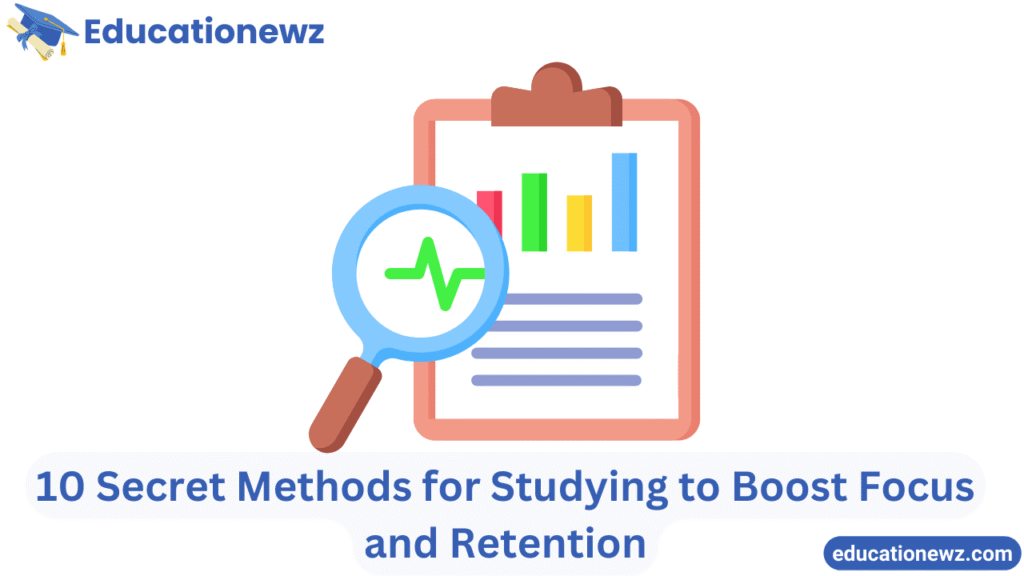The 10 Secret Methods for Studying are proven strategies like active recall, spaced repetition, and self-testing that can help improve focus, retention, and exam performance.
Studying for exams can sometimes feel like you’re trapped in a never-ending cycle of memorizing and cramming. But what if I told you that there’s a smarter way to study—one that doesn’t involve hours of endless reviewing? In this article, I’ll reveal the 10 secret methods for studying that can help you study smarter, not harder. These aren’t your typical study tips, but scientifically backed methods that actually work. Whether you’re prepping for exams or just want to boost your memory, these strategies will guide you to academic success. Let’s dive in and unlock the secrets to studying effectively!
Why Traditional Study Methods Aren’t Enough

Let’s be honest—how many of us have stuck to the same old study routine for years, only to find ourselves staring blankly at the same pages over and over again? Whether it’s reading, highlighting, or writing notes a hundred times, these traditional study methods don’t always work. Sure, they might seem familiar and safe, but they often leave us frustrated and wondering why we’re not making any real progress.
What many students don’t realize is that there are scientifically proven study methods that can help boost focus, improve memory retention, and ultimately, increase exam scores. It’s time to let go of outdated strategies and try something smarter. In this article, we’ll explore the 7 secret methods for studying that can actually make a difference in how you learn. These aren’t just quick fixes, but research-backed techniques that help your brain work more efficiently and retain information longer.
If you’re tired of feeling overwhelmed and unsure, it’s time to switch gears. Let’s dive into the smarter way to study and make those grades reflect the effort you’re truly putting in!
The Power of Active Recall
Have you ever tried to remember something and suddenly it clicks? That’s the magic of active recall. Instead of passively reading or highlighting, active recall forces you to retrieve information from memory. It’s like working out your brain—each time you actively pull information from your mind, you’re strengthening the connections in your brain that make recalling that info easier next time.
So, how do you apply it? You can use flashcards, quiz yourself regularly, or even summarize your notes from memory. I remember when I started using this method during exam prep, and I was surprised at how quickly I could remember complex concepts just by testing myself rather than rereading the textbook. It’s one of the scientifically proven study methods that really pays off!
Here’s how to make the most of active recall:
- Use flashcards with questions on one side and answers on the other.
- Try self-quizzing after each study session to check your understanding.
- Summarize notes or concepts without looking at the textbook.
By practicing active recall consistently, you’re giving your brain the workout it needs to truly retain information for the long term. Trust me, you’ll feel the difference when exam day arrives.
Spaced Repetition – The Key to Long-Term Retention
Ever tried cramming the night before an exam? We’ve all been there. But here’s the problem: that information doesn’t stick. It’s like trying to fill a bucket with holes—no matter how hard you try, it all leaks out. That’s where spaced repetition comes in.
The idea behind this method is simple: instead of cramming, you review material at increasing intervals. Studies show that spacing out your study sessions helps reinforce memories and makes it easier to remember information long-term. Apps like Anki or Quizlet use algorithms to help you space out your reviews based on what you’re struggling with most. Or, you can set up your own review schedule using a simple table.
Why does it work? It’s based on something called the spacing effect, which is the psychological principle that we remember things better when we review them over time, rather than all at once. It’s not about studying more; it’s about studying smarter.
Here’s how you can use spaced repetition:
- Break your study material into chunks and review it on different days.
- Use apps like Anki or Quizlet to automate the process.
- Gradually increase the time between your review sessions as you master the material.
With spaced repetition, you’re making sure your brain has the time it needs to properly encode and store information.
The Pomodoro Technique for Better Focus
Sometimes, staying focused for long periods can feel impossible, especially when studying for hours on end. That’s where the Pomodoro Technique comes in. This method involves breaking your study time into short, focused intervals (usually 25 minutes), followed by short breaks. The idea is that by working in smaller bursts, you can maintain high levels of focus without burning out.
The beauty of this technique is its simplicity. You study for 25 minutes—no distractions, no multitasking—and then take a 5-minute break. After four cycles, you take a longer break of 15-30 minutes. It’s perfect for keeping your mind fresh and energized throughout your study sessions.
Here’s how you can implement the Pomodoro Technique:
- Set a timer for 25 minutes and focus solely on your task.
- Take a 5-minute break after each Pomodoro session. Stretch, grab a snack, or just relax.
- After completing 4 Pomodoros, take a longer break to recharge.
Trust me, when you try this method, you’ll notice how much more productive you feel. Plus, you’ll have plenty of energy for your next study session!
Mind Mapping for Visual Learners

Not all of us are built for reading endless paragraphs or listening to long lectures. If you’re a visual learner, then mind mapping might be your secret weapon. This technique involves creating a visual diagram to organize information around a central idea, which makes complex topics easier to understand and retain.
The beauty of mind mapping is that it helps your brain organize information logically and visually. You start with a central concept and branch out with related ideas and details, all connected by lines and colors. It’s a creative and fun way to break down complex subjects into bite-sized, manageable parts.
How can you use it effectively?
- Start with a central topic and add branches for subtopics.
- Use colors, symbols, and keywords to make it visually appealing and easy to remember.
- Don’t worry about being perfect—just focus on capturing the essence of the concept.
Mind mapping is not just for organizing notes, but also for boosting creativity and helping you visualize the relationships between ideas. It’s one of those 10 secret study tips to score highest in exam that can make all the difference when revising.
Self-Testing – A Powerful Tool for Active Learning
If you’re serious about mastering a subject, self-testing is a must. Instead of just reading through your notes, try quizzing yourself to really test your understanding. Self-testing doesn’t just tell you what you know—it reveals the gaps in your knowledge so you can fill them in before the big day.
I can’t emphasize enough how powerful this method is. By regularly testing yourself, you’re actively engaging with the material, which helps reinforce your memory and builds a deeper understanding of the concepts. This is a form of active learning that ensures you’re not just memorizing but truly learning.
Here’s how to use self-testing to your advantage:
- Create your own quizzes based on the material you’ve learned.
- Try using past papers or sample questions to test your knowledge.
- Review your results to identify areas where you need more practice.
By integrating self-testing into your study routine, you’ll make sure that you’re not just learning—but mastering—the material, which is key to acing those exams.
The Cornell Note-Taking System
Ever struggled with messy notes that don’t make sense when you look back at them? The Cornell Note-Taking System could be your new best friend. This method is a simple yet highly effective way to structure your notes, making it easier to review and retain information. You divide your paper into three sections: notes, cues, and summary.
The real magic of this system is its organization. By separating your notes from your questions or cues, and then summarizing the material, you make it easier to identify key concepts and reinforce your learning. I remember when I first tried this technique—it was like suddenly everything fell into place. Instead of scribbling random thoughts, I had organized, clear notes that helped me study more effectively.
How to use the Cornell Method:
- Divide your page into three sections: one for notes, one for cues/questions, and one for a summary.
- Take notes during class or study sessions in the largest section.
- Afterward, write questions or key points in the cue section.
- At the bottom, summarize the main ideas in your own words.
With this method, your notes won’t just be a pile of random facts—they’ll be organized, digestible, and perfect for revision. The Cornell Method is truly one of the best studying methods and tips out there.
Teaching Someone Else
Have you ever explained something to a friend or family member, and suddenly you understand it better yourself? That’s the power of teaching others. When you teach, you have to clarify and simplify concepts, which helps you solidify your own understanding. It’s like the “aha” moment for both you and the person you’re teaching.
Explaining ideas forces you to reframe them in a way that makes sense, often helping you spot gaps in your own knowledge. When I started teaching some of my classmates in university, I realized how much I had missed in my own notes, just by trying to explain it clearly to someone else.
Here’s how you can use teaching to improve your study:
- Teach a friend or family member what you’ve learned. If no one’s available, pretend you’re the teacher.
- Use simple language to explain complex ideas—if you can explain it clearly, it means you truly understand.
- Record your explanations and play them back to see if you missed anything.
Teaching others is one of the 3 secret study tips that’s helped me score better every time, and it’s a technique worth trying if you want to improve your exam performance.
Create a Distraction-Free Study Environment
Do you ever find yourself staring at your notes, but your mind keeps drifting off to other things? A distraction-free study environment is key to staying focused. If your study space is cluttered or noisy, it can be hard to concentrate. Your environment plays a huge role in how well you can focus.
When I started studying in a quiet, organized space, I noticed a huge difference in my productivity. I removed all unnecessary distractions, and suddenly, I was more focused and efficient. It’s all about creating an environment that encourages concentration and reduces the temptation to check your phone or wander off mentally.
Here’s how to create the perfect study space:
- Keep your study area clean and well-lit.
- Remove distractions: put your phone on silent, close social media tabs, and set boundaries with family or roommates.
- Use tools like noise-cancelling headphones or focus apps like Forest to help you stay on task.
When you create a space dedicated to studying, it’s easier to get in the zone. Best studying methods and tips don’t just rely on what you do; they depend on where you do it too.
Utilizing Technology to Stay on Track

In today’s digital world, we’re lucky to have access to some amazing tools that can enhance our study sessions. Digital tools like flashcards, note-taking apps, and task managers can help keep you organized and motivated. One of the biggest challenges with studying is staying on track, and that’s where technology shines.
For instance, I love using Anki for spaced repetition and Evernote for keeping my notes organized. Apps like Todoist or Trello also help me break my study tasks into manageable steps. Using these tools not only keeps me organized but also keeps me accountable, ensuring I don’t miss a review session or forget an important task.
Here’s how you can use technology to stay on track:
- Use Anki or Quizlet for digital flashcards and spaced repetition.
- Take digital notes with apps like Evernote or OneNote for easy organization and quick access.
- Stay on top of tasks with Todoist or Trello to create to-do lists and deadlines.
By using these tools, you can turn your study sessions into a more efficient, streamlined experience. It’s one of the 10 secret methods for studying that’s all about working smarter, not harder.
FAQs (Frequently Asked Questions)
1. What are the 10 secret methods for studying?
- Active Recall, Spaced Repetition, Pomodoro Technique, Mind Mapping, Self-Testing, Cornell Method, Teaching Others, Distraction-Free Environment, Using Technology, and Creating a Study Schedule.
2. How can I apply spaced repetition to my study routine?
- Use tools like Anki or Quizlet to create digital flashcards and set review intervals. Start with shorter intervals and gradually increase the time between reviews.
3. What’s the best study method for memorizing information?
- Active Recall and Spaced Repetition are two of the most effective methods for retaining information long-term.
4. How can technology help me study better?
- Use apps like Anki for flashcards, Todoist or Trello for task management, and Evernote for note-taking. These tools can help you stay organized, track progress, and keep procrastination at bay.
Conclusion
So there you have it! The 10 secret methods for studying that can really change the way you approach learning. From using active recall and spaced repetition to creating a distraction-free environment and leveraging the power of technology, these strategies are designed to help you retain more, focus better, and ultimately score higher in your exams.
But the key is consistency. Don’t try to do it all at once—start applying these methods one by one and see how they work for you. With a little practice, you’ll notice a big improvement in your academic performance.
Start today. Your future self will thank you! Please follow our blog Educationewz.



